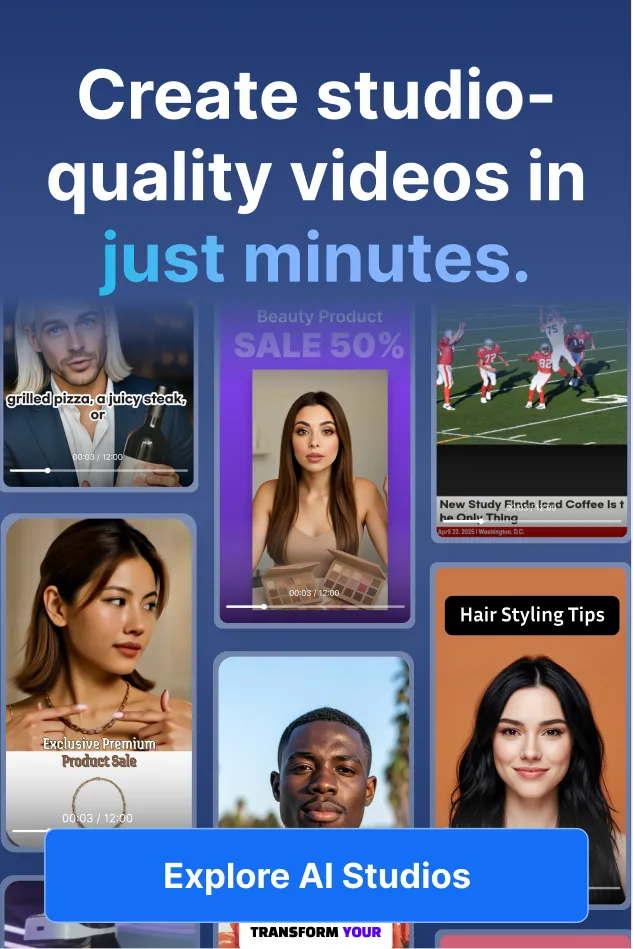Turn Text into Videos?
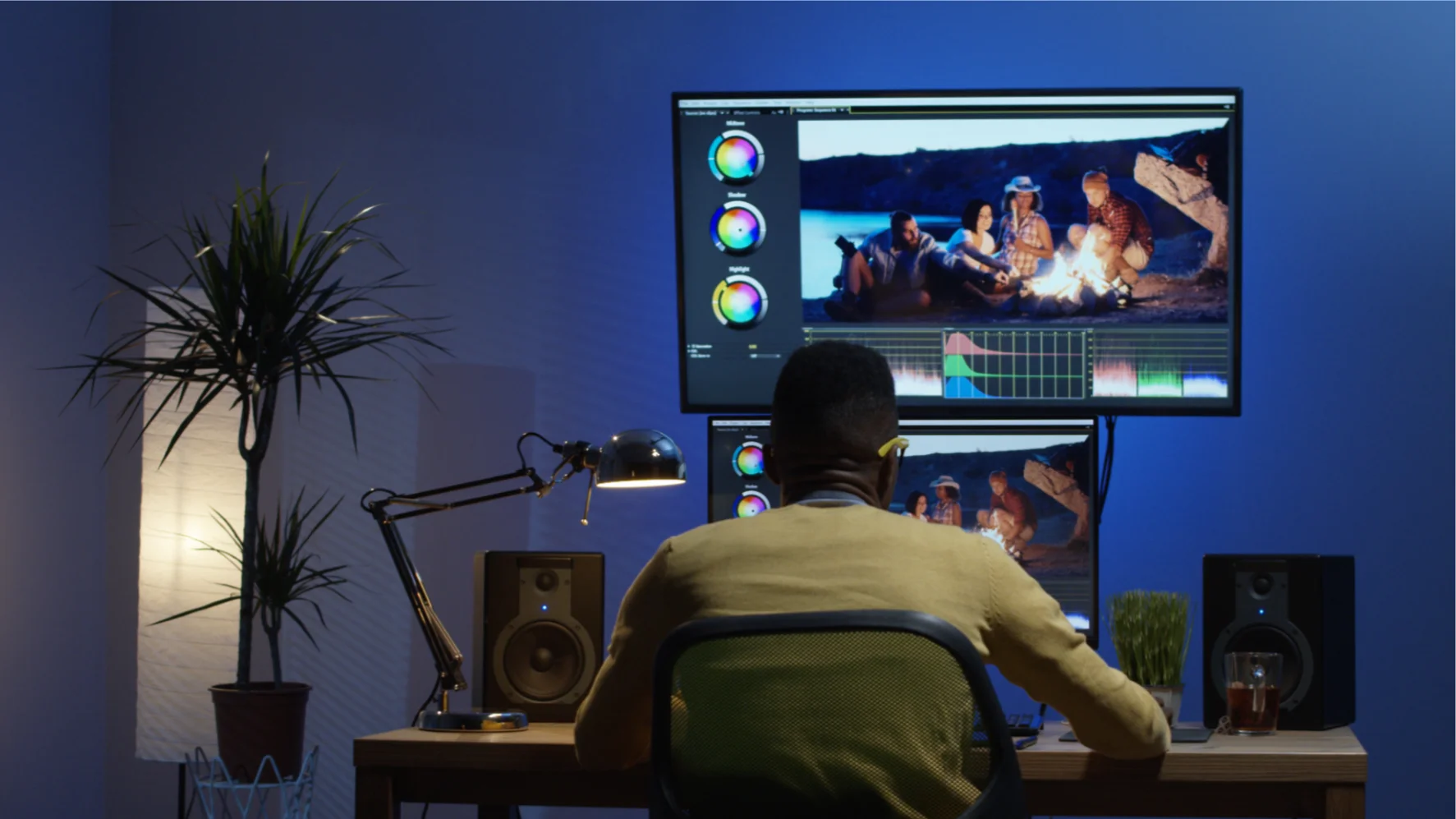
Have you ever wondered how to breathe new life into your written content, transforming static words into dynamic videos? In an era where digital content is king, it's no secret that videos have a compelling edge. They boast a staggering 1200% more shares than text and images combined, according to Social Media Today. But how can you, without extensive technical know-how or a hefty budget, jump on the video bandwagon and turn your articles into engaging visual stories? Whether you're a blogger, marketer, or entrepreneur, this blog post is your step-by-step guide to making that leap from text to screen.
The process might seem daunting, but with the right tools and techniques, it's easier than you think. Are you ready to unlock the potential of your articles and tap into the vast audience of video content consumers? From the simplicity of automated video creation tools to the flexibility of editing software, we'll explore methods that cater to both beginners and seasoned pros. And if you hit a snag along the way, don't worry—we've got you covered with solutions to common issues. Plus, we'll delve into the intriguing question: Can AI revolutionize content creation? Join us as we unveil the secrets to quickly turning articles into captivating videos that can amplify your message and captivate your audience.
Method 1: Using Automated Video Creation Tools

The proliferation of video content across various platforms has necessitated the development of tools that streamline the video production process. In an era where time is of the essence, and the appetite for dynamic content is insatiable, automated video creation tools have emerged as a game-changer. These tools are designed to simplify the complexities involved in creating engaging video content, making it accessible to a wider range of creators, from professionals to casual enthusiasts. One such innovation leading the charge is DeepBrain AI's AI Studios, which offers a unique solution for transforming text-based content into captivating video narratives.
About DeepBrain AI's AI Studios
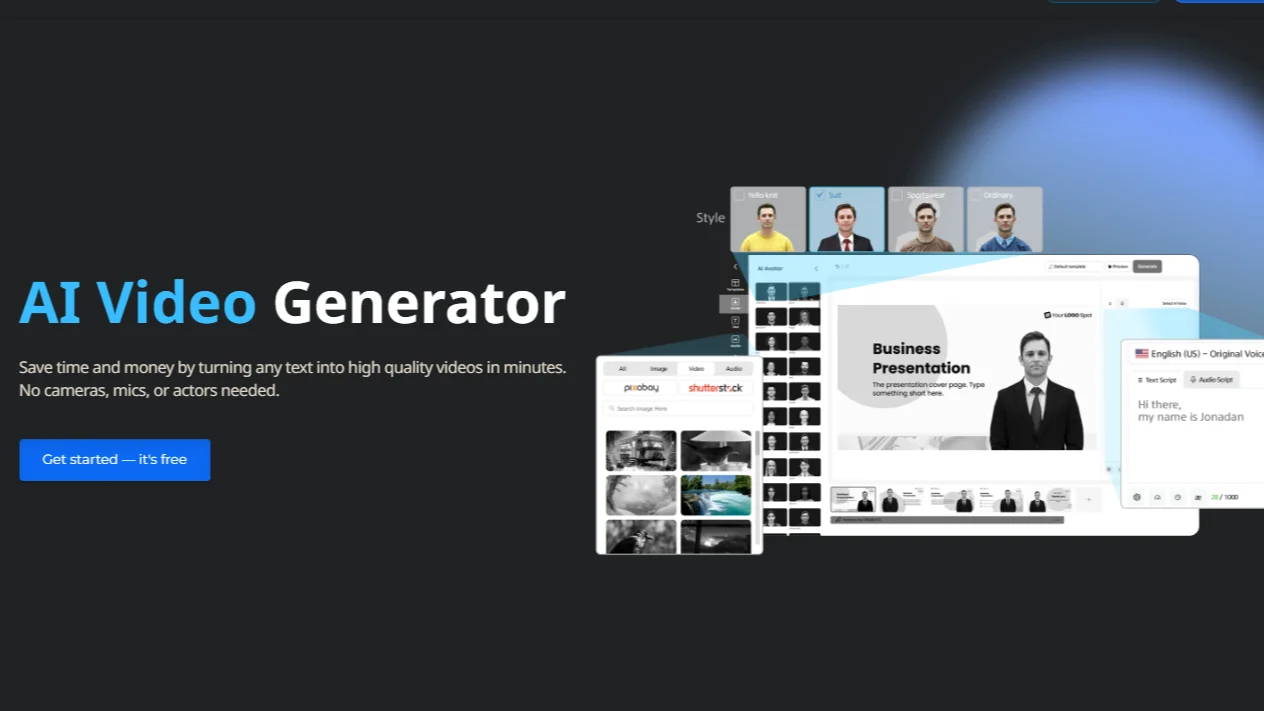
In today's digital landscape, where the demand for immersive and interactive content is skyrocketing, DeepBrain AI's AI Studios stands out as a revolutionary platform that empowers content creators. It provides a seamless experience for converting written materials into visually stunning videos. The platform's intuitive "Article to Video" feature is a testament to the power of artificial intelligence in modern content creation.
DeepBrain AI's AI Studios harnesses advanced AI technologies to simplify the traditionally complex video production process. This innovation enables creators, regardless of their technical skills in video editing, to produce high-quality videos with minimal effort. The AI-driven workflow automates tasks such as animation, voice-over generation, and editing, which not only saves time but also ensures consistency and professionalism in the final product.
Moreover, the platform's capabilities are not limited to just simplifying video creation. It also offers a range of customizable templates and digital avatars that can be tailored to match the brand identity and the intended message of the content creator. These features allow for a high degree of personalization, making each video unique and engaging. As a result, creators can effortlessly enhance their digital presence and connect with their audience through professional and compelling video content that stands out in a crowded digital ecosystem.
Exploring the "Article to Video" Feature

The "Article to Video" feature is a game-changer in the realm of content creation, allowing users to transform text-based articles into full-fledged videos in a matter of minutes. With this feature, users can input an article or an article URL, and DeepBrain AI's sophisticated algorithms will extract the key points and content, converting them into a dynamic video complete with a script, relevant video backgrounds, audio, and even an AI presenter.
The process is incredibly efficient, taking only about 5 to 10 minutes to generate a draft video. After this automated generation, users have the option to further customize the draft. They can choose from various AI presenters to deliver the content, select appropriate backgrounds, and even adjust the voice-over to ensure the tone matches the intended message of the video. This level of customization is not just about aesthetics; it's about creating a video that resonates with the target audience and conveys information in the most impactful way.
For content creators looking to scale their video production or those who want to repurpose their written content for a broader audience, DeepBrain AI's "Article to Video" feature offers a powerful tool. It democratizes video creation, making it accessible to creators with varying levels of expertise and resources. This feature is not just about saving time; it's about empowering creators to tell their stories visually and engagingly, enhancing their digital presence in an increasingly video-centric online world.
Step-by-Step Guide to Generate Videos with AI Studios
Step 1: Input Your Article into the Platform
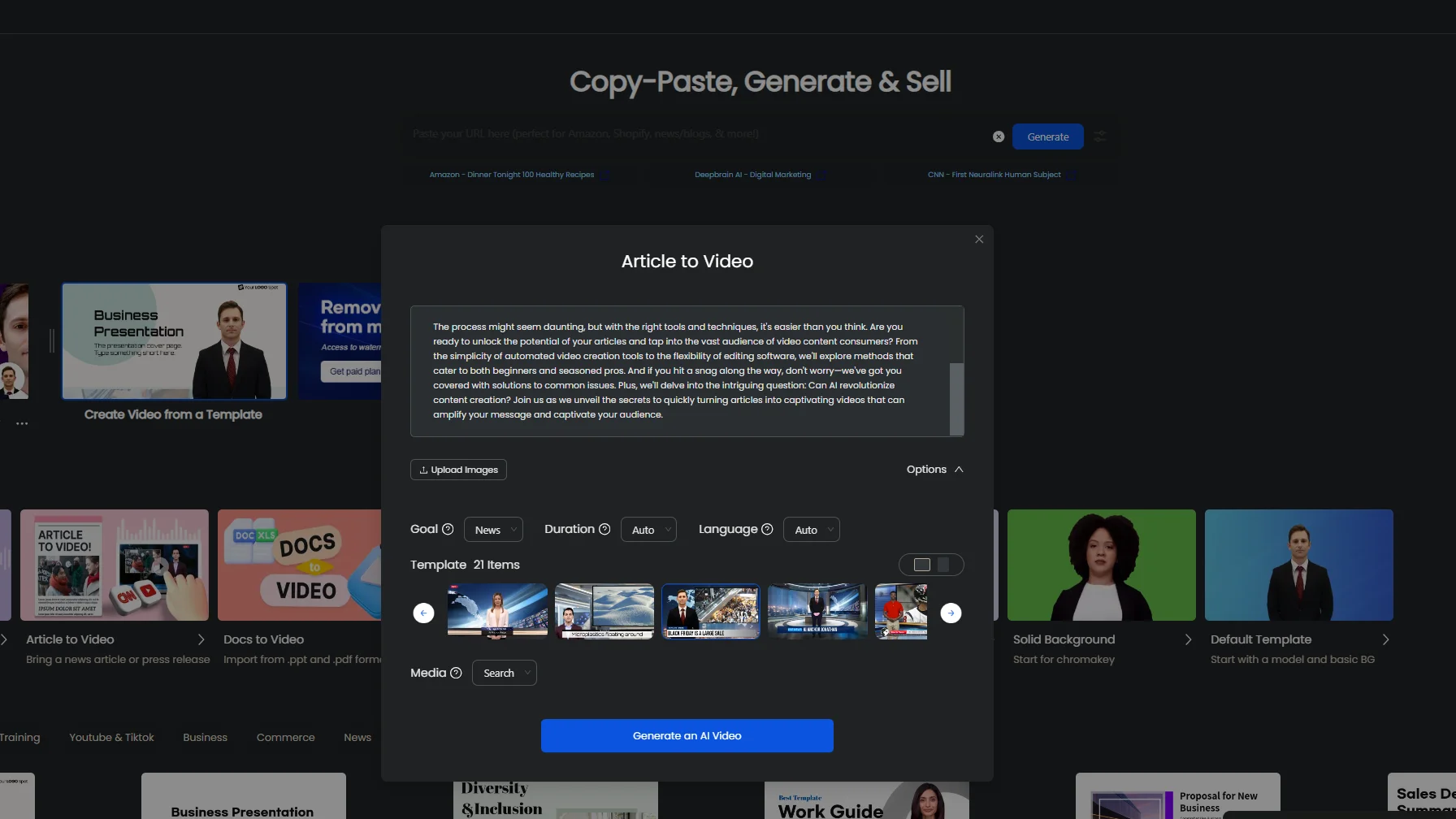
DeepBrain AI's AI Studios simplifies the process of converting your article into a video script:
- Begin by copying the text of your article.
- In the AI Studios interface, find the section dedicated to the "Article to Video" feature and paste your text there.
- The platform's AI will analyze the content and structure it appropriately for video format.
Step 2: Customize and Enhance Your Video
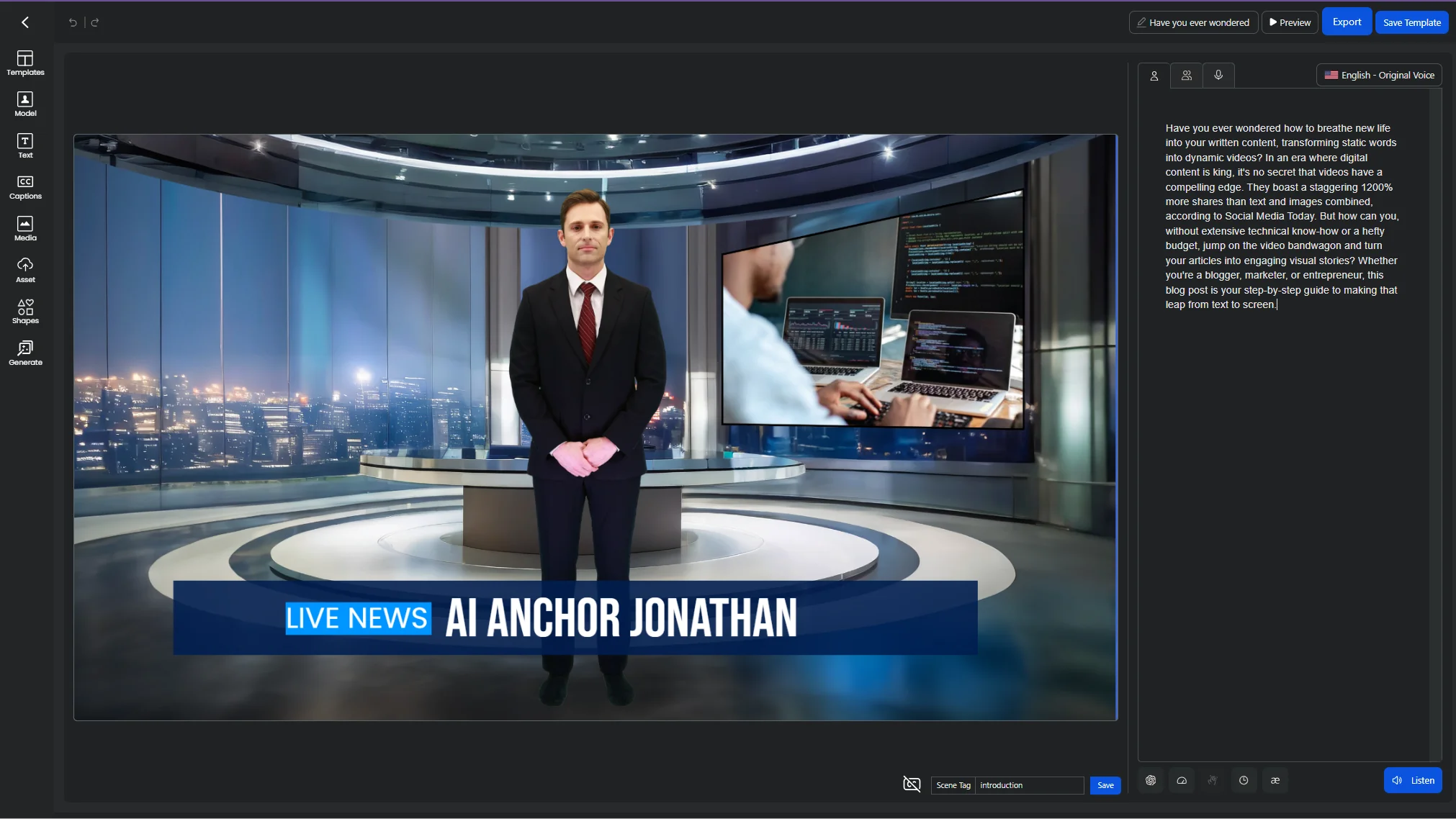
DeepBrain AI's AI Studios provides an intuitive customization process:
- Utilize the AI's suggestions for imagery and clips that are relevant to your article's content, or select from a vast library to personalize your video further.
- Refine the text overlays to emphasize the most critical points of your article, ensuring they are clear and impactful alongside the visuals.
- Incorporate a soundtrack or use the platform's text-to-speech technology to add a voiceover, lending a professional touch to your video.
Step 3: Review, Export, and Share Your Video
Before sharing your video with the world, make sure it meets your standards:
- Use the preview function to watch your video, paying close attention to the synchronization between text, visuals, and audio.
- Once satisfied, export the video in your preferred format and resolution, ready for distribution.
- Share your video across social media, websites, or any other platforms where your audience engages with your content.
💡 Troubleshooting and Optimization 💡
- If the video content does not align perfectly with the text, DeepBrain AI's editing tools allow you to adjust timings and transitions manually.
- Should you encounter any voiceover issues, review the platform's text-to-speech options for different languages and accents, or consider uploading a custom voice recording for a personal touch.
Pros & Cons of Using Automated Video Creation Tools
While automated video creation tools like DeepBrain AI's AI Studios offer significant advantages, it's important to consider both the benefits and potential limitations.
Pros:
- Time Efficiency: Automated tools drastically reduce the time required to produce videos, enabling rapid content creation and faster time-to-market.
- Accessibility: These platforms are user-friendly, making video production possible for individuals with little to no technical background in video editing.
- Consistency: AI-driven tools maintain a consistent quality and style across videos, which is crucial for brand identity and professional presentation.
- Cost-Effectiveness: By automating various aspects of video production, creators can save on the costs associated with hiring professionals for tasks like animation and voice-over work.
- Scalability: With the ability to quickly produce videos, creators can scale their content output to meet the demands of their audience or clients.
Cons:
- Creative Limitations: While AI tools offer customization options, there may be constraints on the level of creativity and uniqueness compared to videos produced by skilled human professionals.
- Generic Feel: Some audiences may find AI-generated videos to lack the personal touch and emotional connection that human-created content offers.
- Dependence on Technology: Heavy reliance on automated tools might limit skill development in traditional video production techniques, which could be a disadvantage if the technology fails or becomes obsolete.
- Potential for Misrepresentation: If not carefully monitored, AI-generated content could inadvertently misrepresent information or tone, leading to misunderstandings with the audience.
Method 2: Creating Videos with Editing Software

In the ever-evolving digital age, the demand for captivating video content continues to rise, prompting the need for efficient video editing software. As we navigate a world where immediacy is valued and audiences crave dynamic content, video editing software has become indispensable for content creators. These applications are meticulously crafted to address the intricate challenges of producing engaging video content, rendering them essential for a diverse array of users, from professional editors to hobbyists. A standout in this field is Adobe Premiere Pro, which offers a comprehensive suite of tools for creating polished video narratives.
About Adobe Premiere Pro
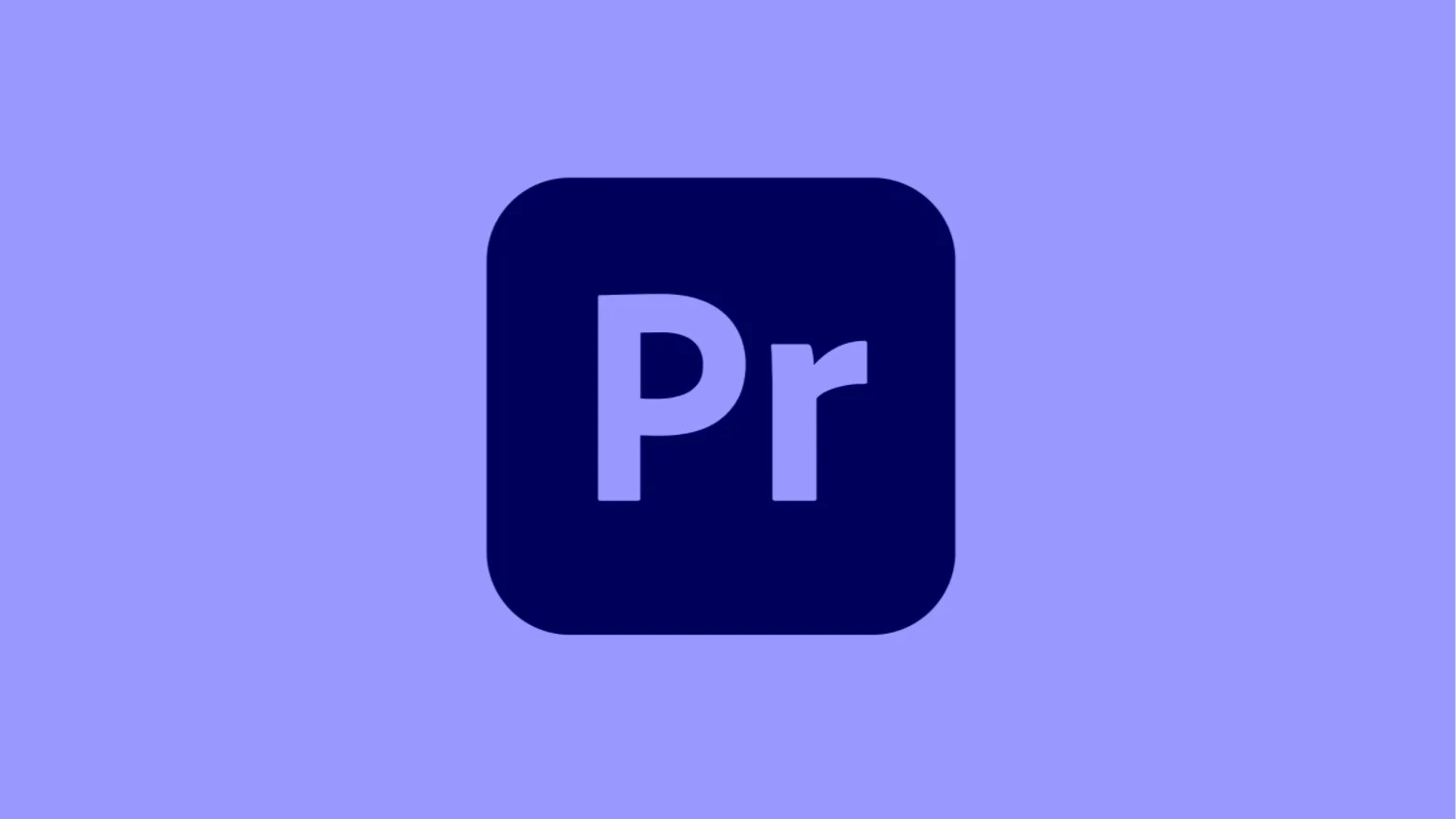
In the realm of digital content creation, where engaging and interactive experiences are highly sought after, Adobe Premiere Pro is recognized as a leading video editing platform. It provides a robust and user-friendly environment for turning raw footage into visually impressive videos. The software's extensive range of features, including its "Non-Linear Editing System," exemplifies the transformative potential of cutting-edge technology in the hands of content creators.
Adobe Premiere Pro leverages sophisticated technologies to streamline the video editing process. This software enables creators of all skill levels to craft high-quality videos with precision and creativity. The workflow in Premiere Pro is designed to facilitate tasks such as cutting and splicing, color grading, and adding special effects, which not only saves time but also allows for artistic expression in every project.
Additionally, Premiere Pro is not just about editing efficiency. It offers a plethora of customizable templates, transitions, and effects that can be adapted to suit the creator's vision and the content's purpose. These capabilities allow for significant personalization, ensuring each video is unique and resonates with its intended audience. As a result, creators can effectively bolster their digital footprint and captivate their viewers with professional and compelling video content that distinguishes itself in the vast digital landscape.
Step-by-Step Guide to Editing with Adobe Premiere Pro
Step 1: Import and Organize Your Media
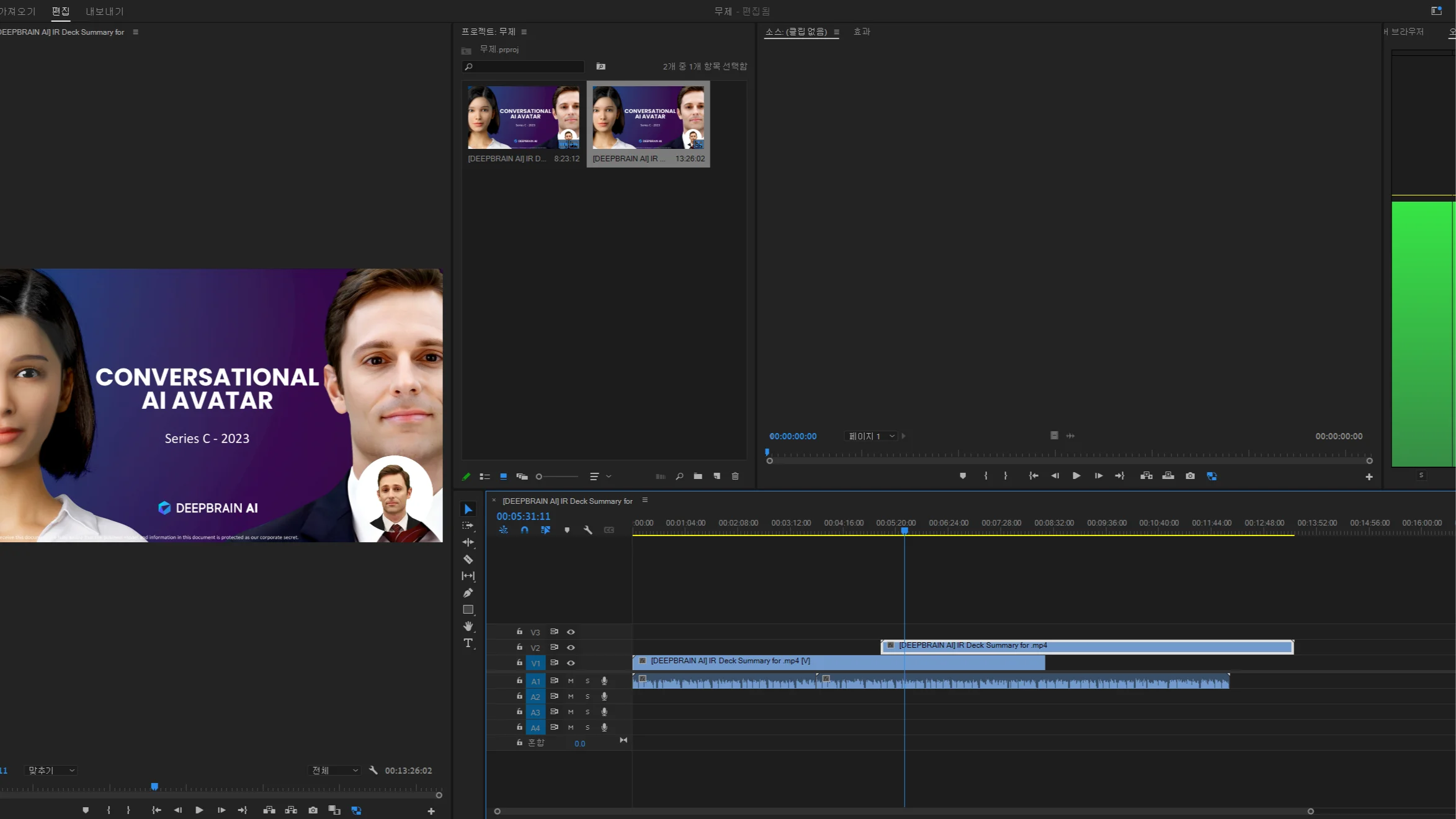
Adobe Premiere Pro simplifies the initial stages of video editing:
- Start by importing your video clips, audio files, and images into the project.
- Organize your assets into bins within Premiere Pro for easy access and management.
- Drag and drop your clips onto the timeline to begin crafting your video narrative.
Step 2: Edit and Refine Your Video
Adobe Premiere Pro's interface facilitates a smooth editing experience:
- Use the software's cutting tools to trim clips and remove unwanted segments, refining the story you wish to tell.
- Experiment with transitions and effects to add depth and dimension to your video, enhancing the viewer's experience.
- Incorporate text and graphics to highlight important information or add context to your visuals.
Step 3: Finalize and Export Your Creation
Ensure your video meets your expectations before sharing it:
- Preview your edited video within Premiere Pro, paying attention to detail and overall flow.
- Once you're satisfied, export your video in the desired format and resolution, optimized for your distribution channels.
- Share your creation on social media, websites, or other platforms to engage with your audience.
💡 Editing Tips and Tricks 💡
- Clip Alignment or Pacing Issues: Use Premiere Pro's Ripple Edit and Rolling Edit tools for accurate adjustments.
- Voiceover or Audio Enhancements: Look into Premiere Pro's audio effects and mixing options to obtain a clear and balanced sound output.
Pros & Cons of Using Video Editing Software
While video editing software like Adobe Premiere Pro offers numerous benefits, it's vital to weigh both the positive aspects and potential drawbacks.
Pros:
- Creative Control: Editing software provides comprehensive tools that empower creators to execute their vision with granular control over every element.
- Professional Results: With advanced features, users can achieve a level of quality akin to what professionals deliver.
- Flexibility: The ability to manipulate clips, add effects, and adjust audio allows for endless creative possibilities.
- Skill Development: Working with sophisticated software enhances the user's editing skills, which are valuable in the evolving content creation landscape.
- Collaboration: Many editing programs support collaborative workflows, enabling teams to work together efficiently on projects.
Cons:
- Learning Curve: The complexity of professional editing software can be daunting for beginners, requiring time and dedication to master.
- Cost: High-end editing applications often come with a subscription or purchase price that may be prohibitive for some users.
- Hardware Requirements: Editing software typically requires powerful computers with high-end specifications to run smoothly.
- Time-Consuming: Unlike automated tools, manual editing is a time-intensive process that demands attention to detail.
- Overwhelming Options: The vast array of features and settings can be overwhelming, potentially leading to decision paralysis for some editors.
Common Issues and Solutions
- Quality Loss After Export: Ensure export settings match the desired quality and platform requirements.
- Long Rendering Times: Close other programs while rendering and consider upgrading your hardware if this is a recurring issue.
- Limited Stock Footage: Use websites like Pixabay or Pexels for free stock footage or invest in a subscription to a stock library.
Can AI Revolutionize Content Creation?

In conclusion, the journey from article to video has been demystified, with tools like DeepBrain AI's AI Studios and Adobe Premiere Pro providing accessible and scalable solutions for content creators. DeepBrain AI's AI Studios, with its "Article to Video" feature, offers a revolutionary approach that leverages artificial intelligence to transform written content into engaging video narratives in a fraction of the time it would take to do so manually. This tool is a boon for marketers, bloggers, and content creators aiming to amplify their reach and cater to the visual preferences of their audience. The pros of using such automated tools—time efficiency, accessibility, consistency, cost-effectiveness, and scalability—far outweigh the cons, which include creative limitations and a potential generic feel.
On the other hand, Adobe Premiere Pro caters to those who seek greater creative control and wish to produce content with a professional touch. The software's comprehensive editing suite allows for a high degree of personalization and flexibility, offering an invaluable platform for skill development in video production. Despite the learning curve and hardware requirements, the benefits of using such advanced editing software are clear, with the potential for professional results and collaborative project management.
Both methods, automated video creation tools and traditional video editing software, present viable pathways for content creators to adapt and thrive in an increasingly video-centric digital landscape. The choice between them hinges on the creator's specific needs, expertise, and resources. As we forge ahead into a future where video content reigns supreme, the question remains: Will AI continue to redefine the boundaries of content creation, or will the human touch retain its irreplaceable value in storytelling? Only time will tell, but one thing is certain—the fusion of technology and creativity will continue to push the envelope, offering ever more innovative ways to capture and hold the collective imagination of audiences worldwide.


